There is no other way to put it: the Karkonosze Mountains in Poland are fascinating. In addition to the beautiful, relaxing mountain scenery, you will find many interesting legends hidden amongst the rocks scattered throughout the mountain range. In this guide to the Polish Karkonosze Mountains and surrounding areas, I will tell you everything you need to know to plan your own trip to this magical place.
Table of Contents
Where are the Karkonosze Mountains?
The Karkonosze (“Giant”) Mountains, located in southwestern Poland on the border with the Czech Republic, are the highest range of the Sudetes. The range extends from Szklarska Pass to Lubawska Pass and has been a National Park since 1959. The best way to visit the Karkonosze Mountains is from a city like Karpacz or Szklarska Poręba. One of the most renowned characteristics of these mountains are the Karkonosze Rocks – massive rock formations known for their shapes and the legends about them. The Karkonosze Mountains are composed of various types of granite, which you can see on the trails.
How many days are enough for a visit to the Karkonosze Mountains?
It depends on your interests. You could easily spend just a weekend there if your main goal is, for example, to climb Śnieżka, the highest peak. Between hiking trails, learning about the various Karkonosze Rocks, chasing waterfalls, visiting the surrounding castles, and exploring the cities of Szklarska Poręba and Karpacz, you could easily spend a week here, if not more. It’s really up to what you want out of the trip. After all, vacation is about relaxation, so there is no need to rush.
When is the best time to visit?
The good news is that every season has something to offer, depending on whether you prefer hiking or skiing. There are more tourists here during summer, but autumn can also be quite crowded, even when the weather is less than ideal. At the beginning of the school year (mainly September), you can find a lot of young people on fieldtrips.
The Karkonosze Mountains and surrounding areas in seven days: A proposed itinerary
Day 1: Szklarska Poręba
On the first day after arrival, I suggest stretching your legs by going sightseeing in Szklarska Poręba. On 1 Maja Street, you will find many restaurants and souvenir shops as well as a statue of the legendary Mountain Spirit. This is a great chance to admire the beautifully preserved architecture of the city.
Alternatively, you can leave sightseeing in Szklarska Poręba for a rainy day and seek out some of these attractions to get acquainted with the history and art of the area.
- Leśna Huta. This glasswork establishment dates back to the 15th century. It is worth visiting not only to learn about the glassmaking history of this area, but also to see the fascinating glass production process firsthand.
- Old Walloon Cottage. Stop by the home of the Walloons – medieval masters of precious stone processing – to admire the collection of minerals from the Silesian mountains.
- Wlastimilówka. Admire the works of 20th-century painter Wlastimil Hofman, as well as the historic interior of the house and studio.
- House of Gerhart and Carl Hautmann. Visit the house of the Hautmann Brothers, both of whom were outstanding writers. The younger, Carl, is known for his collection on the adventures of the Mountain Spirit, and the older, Gerhart, was awarded the Nobel Prize for life’s work.
- Gallery of Artistic Photography by Jan and Janina Korpal. Admire the Karkonosze landscapes as captured by local 20th-century artist Jan Korpal and his wife, Janina.

Day 2: Kamieńczyk, Szrenica, and Snow Cauldrons
I recommend starting with one of the longer trails near Szklarska Poręba: Red Trail to Szrenica and Śnieżne Kotły (Snow Cauldrons) peaks , which includes the Kamieńczyk Waterfall and the Trzy Świnki (Three Pigs) rock.
Kamieńczyk Waterfall
You will find this charming waterfall (843 meters above sea level/2766 feet) on the route to Szrenica. The waterfall, located in the Kamieńczyk Gorge, is the highest waterfall in the Karkonosze Mountains – 27 meters/89 feet high. You can admire it from the upper platform right next to the Kamieńczyk Mountain Hut for free at any time of the day. However, access to the waterfall is paid and only open in the season between 9 am to 5 pm. To clarify, this means that admission to the park does not entitle you to enter the waterfall. There are narrow metal steps leading down to the bottom of the waterfall, and a helmet is provided for your safety due to the possibility of falling rocks.
You can get to Kamieńczyk by following the Black Trail from Szklarska Poręba or the Red Trail from the parking lot. The two trails meet before reaching the waterfall.
Szrenica, Three Pigs and Snow Cauldrons
The route to Szrenica (1,362 meters above sea level/4469 feet) begins at the same starting place as the route to Kamieńczyk Waterfall. You will reach it by following the Red Trail, a pleasant route with a concrete walkway. From the top, you will be able to admire views of the Jerusalem Basin, the Jizera Mountains, and the Czech Karkonosze Mountains. On the way up, you will pass the Szrenica Mountain Hut, where you can take a break. Alternatively, you can get to Szrenica by chairlift, but you will miss out on the Kamieńczyk Waterfall if you choose this option.

Following the Red Trail from Szrenica, you will pass the Karkonosze rocks. More precisely, you will surely notice the rock formation called Trzy Świnki (Three Pigs), which is located right at the beginning of the Polish-Czech Friendship Trail. The trail along the ridge is very pleasant and boasts beautiful mountain views. Along the way, you also pass Wielki Szyszak peak and its relay tower, a distinct, red-roofed building. Once you pass the building, you’ll get to the peak known as Śnieżne Kotły (Snow Cauldrons), which is 1,490 meters above sea level/4888.
Once you’re done admiring the views, take the Red Trail back to the Yellow Trail. That’s the quickest way back to Szklarska Poręba. However, I recommend stopping at Śnieżne Stawki (Snow Ponds) to get a different angle of the Snow Cauldrons before heading down the Blue Trail and then the Green Trail. You can take a coffee break at the Łabskie Szczyt Mountain Hut and, from there, follow the Yellow Trail back to Szklarska Poręba.
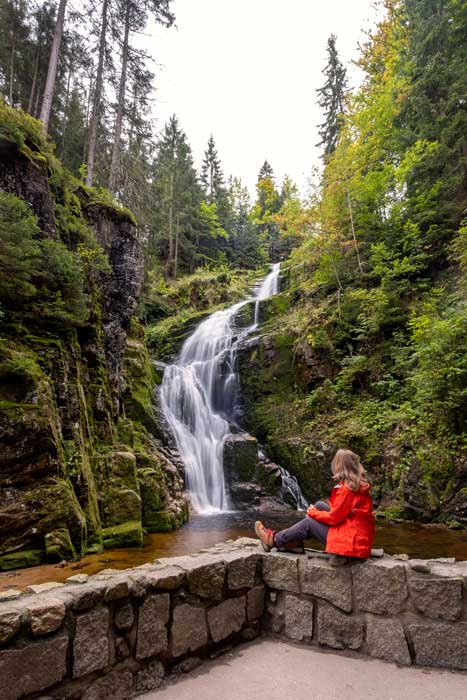
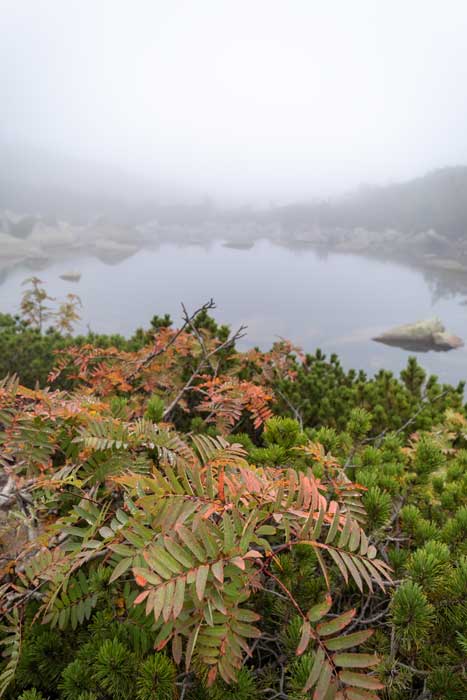
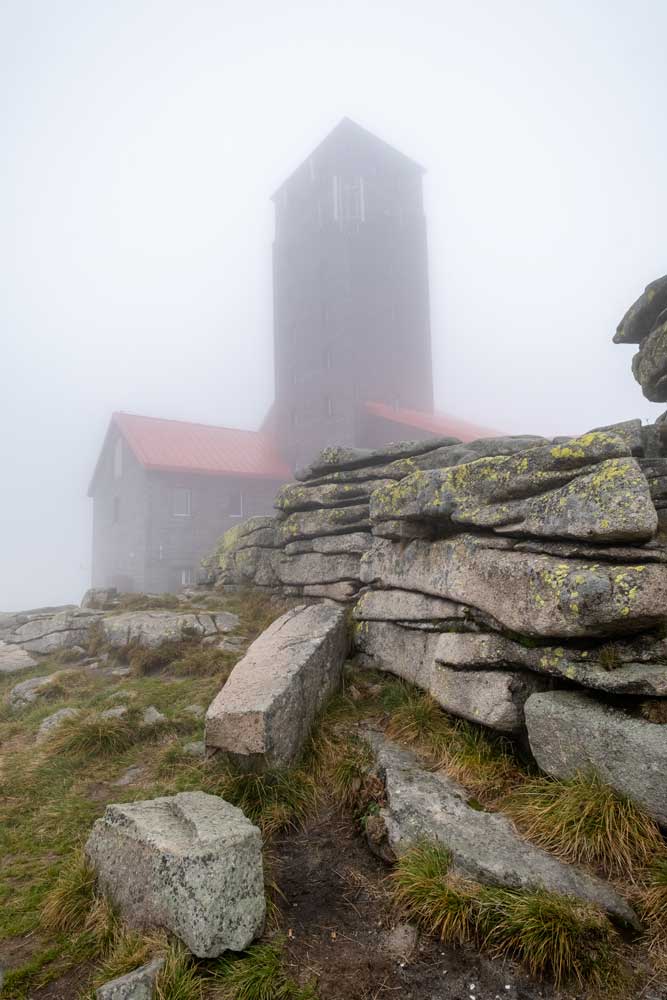
Day 3: Szklarki Waterfall, Chybotek, and Golden View
On the third day, I recommend a lighter schedule so that you can rest after busy Days 1 and 2. I suggest you visit one of the most romantic places in the Karkonosze Mountains, where you can see the Szlarki Waterfall. Then look for treasures hidden under Chybotek rocks, and close out the day by admiring the views from the Złoty Widok (Golden View) overlook.
Szklarski Waterfall (520 meters above sea level/1706 feet) is the second largest waterfall of the Karkonosze Mountains at 13.3 meters/44 feet high. According to legends, the Chybotek rock formation covers the entrance to the underground treasury. From the Golden View overlook, there are beautiful views of the Karkonosze Mountains, the Kamienna Valley, and part of the Jeleniogórska Valley. The Golden View, with its panorama and its benches and deckchairs, is a perfect place to relax.
Szklarki Waterfall
I suggest starting the hike to the Szklarki Waterfall by following the Black trail leading around Szklarska Poręba and then the Blue Trail. The road to the waterfall leads through the forest and is very pleasant. Located in the National Park, the waterfall requires paid admission. For drivers, it is a short walk from the parking lot on Jeleniogórska Street. The good news for people with mobility problems is that the waterfall’s viewpoint is wheelchair accessible. By the waterfall, you will find the Kochanówka Mountain Hut, where you can take a break before continuing your hike.
Chybotek and Golden View
The parking on Jeleniogórska Street is also the closest lot to Chybotek and Golden View, with the trail located right across the street. For those traveling from the Szklarki Waterfall, you can reach the parking lot by following the same Blue Trail then taking the Black Trail uphill. When the trail starts to turn right, continue to climb by following the arrows and then take the Blue Trail. I recommend that you first turn right to Chybotek and then go back and follow the same Blue Trail to Golden View. That same trail will also take you back to Szklarska Poręba.

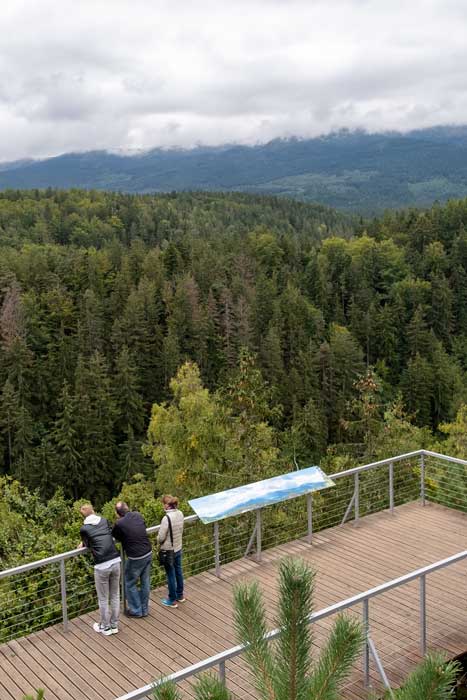
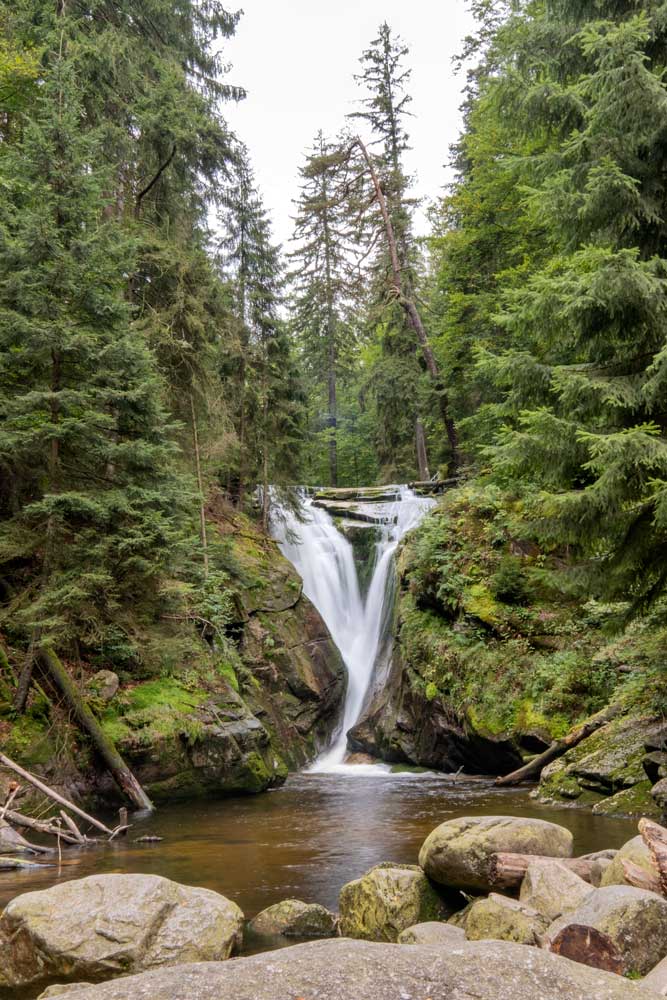
Day 4: Śnieżka, the highest peak of the Karkonosze Mountains
After a day of rest, it’s time to climb the highest peak of the Karkonosze Mountains, Śnieżka (1,602 meters above sea level/5256 feet). On top of Śnieżka, you will find the Metrological Observatory, which provides the most accurate weather on the mountain.
The most interesting and picturesque trail to Śnieżka is the Yellow Trail from the Wang Temple. On the way up, you will pass two more Karkonosze rocks: Pilgrim and Sunflower. From Sunflower, follow the Red Trail to the top. I suggest a short break at the Dom Śląski Mountain Hut before or after hiking to the top of Śnieżka.
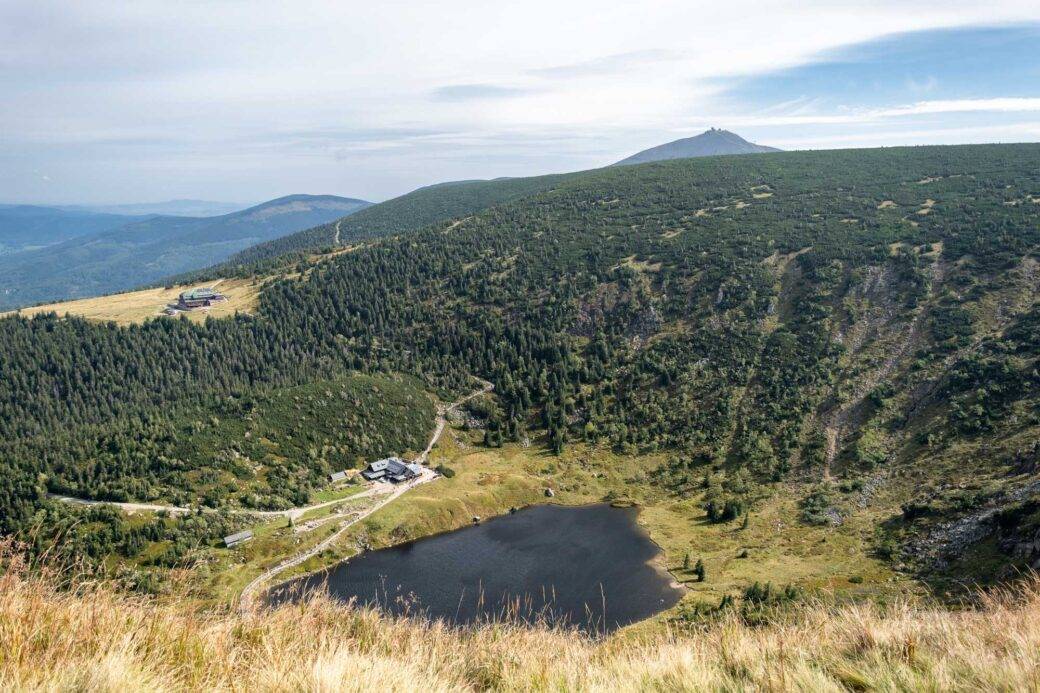
On the way back, follow the Blue Trail toward Dom Śląski, then take Red Trail back. Alternatively, if you are interested in a longer route, stay on the Blue Trail until you reach the Samotnia Mountain Hut, a particularly picturesque mountain hut and one of the oldest in Poland. Right next to it, you will find the Strzecha Akademicka Mountain Hut. If you still decide to take the shorter trail back from Śnieżka, both mountain huts look beautiful from the Red Trail.
Pro Tip. Śnieżka is typically covered in fog. Check the weather before hitting the trail to avoid obscured views and disappointment.

Day 5: High Stone and Death Curve
High Stone
After climbing Śnieżka on Day 4, I recommend taking a shorter route to Wysoki Kamień (High Stone ; 1,058 meters above sea level/3472 feet), which offers one of Szklarska Poręba’s best views of the Jeleniogórska Valley, the Karkonosze Mountains, and the Izera Mountains.
If you’re traveling on foot, start from Szklarska Poręba and head toward the railway station. Drivers can leave their cars in the parking lot right next to the train station. You can get to High Stone by following the Red Trail. The trail itself is very pleasant, although it can be steep at times. At the top, you will find the Wysoki Kamień Mountain Hut, where you can take a coffee and cake break while admiring the views. There is also an observation tower here. Unfortunately, it is temporarily under renovation, but the view from the rocks is very nice.

Death Curve
From High Stone, follow the trail to Zakręt Śmierci (Death Curve; 775 meters above sea level/2543 feet) – a sharp turn in the road that takes its name from the many car accidents that have taken place there. The trail to Death Curve is very pleasant, and you will also find another fantastic viewpoint of the Karkonosze Mountains. To get back to Szklarska Poręba without backtracking along the same trail, you can take the Black Trail right next to the road. You can also return to the city center by public transit. Although the road is a bit busy, it is very pleasant, and you can admire the villas of Szklarska Poręba along the way.
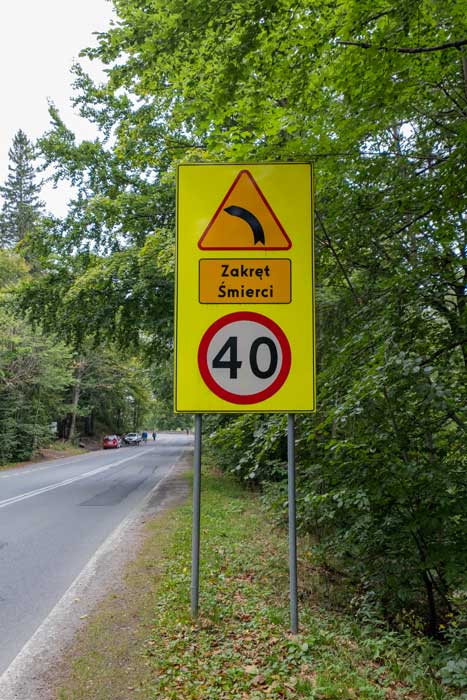
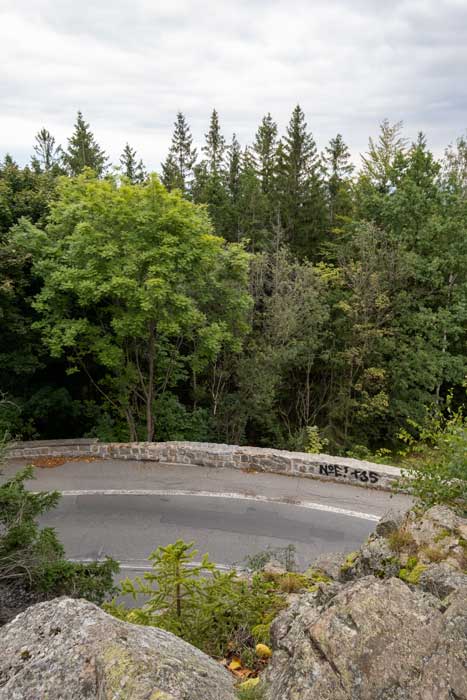
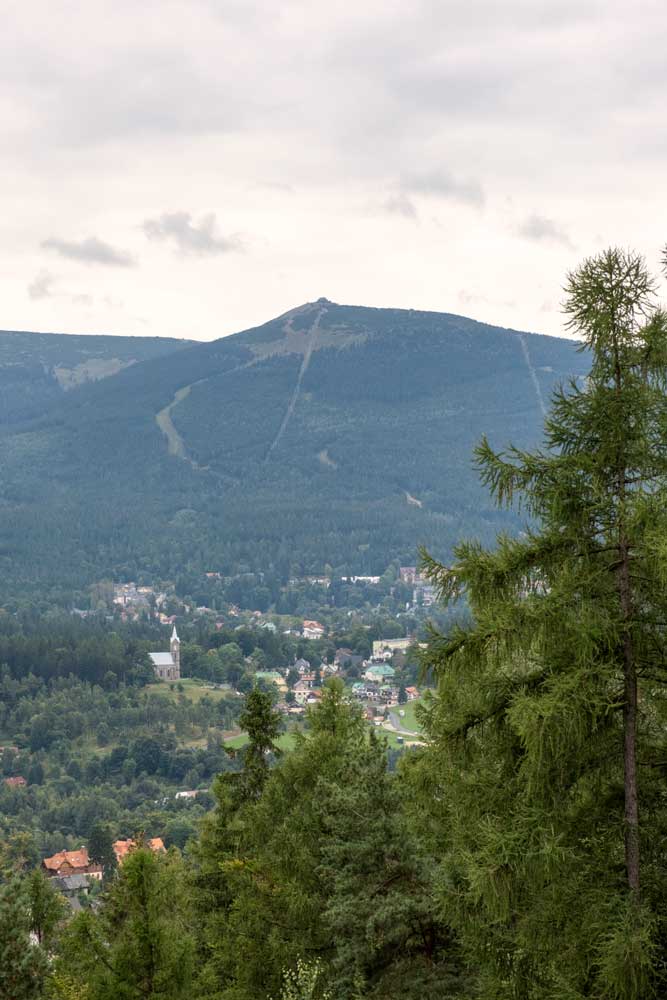
Day 6: Karpacz
After conquering the top peaks of the region and Szklarska Poręba, I suggest visiting Karpacz and its surroundings.
A few attractions not to miss in Karpacz
- Świątynia Wang (Wang Temple), a wooden church originally built in the Norwegian town of Vang and donated to Karpacz in 1842. It is a beautiful example of Scandinavian sacral architecture from the 12th century.
- Dziki Wodospad (The Wild Waterfall) and its dam on the Łomnica River. The dam was built at the beginning of the 20th century to protect the city against floods. It is worth stopping here and relaxing to the sounds of nature.
- Młynek Miłości (A Mill of Love). This miniature mill is a popular spot with couples who are in love. There used to be a mill in this location whose waters, according to legend, had miraculous properties of reciprocating love.
Suggested attractions for a rainy day in Karpacz
- Karkonoskie Tajemnice (Mysteries of the Karkonosze Mountains). It is an underground multimedia exhibition where you will learn more about the history of the Karkonosze Mountains and the legends surrounding the Mountain Spirit.
- Multimedia Museum of the Karkonosze Mountains. Walk through nine chronologically arranged rooms and learn about the history of the Karkonosze Mountains – from the formation of the continents to the present day.
- Museums for the youths in your party. Visit the Toy Museum, where you will find 18th to 20th century toys and dolls from around the world; the Video Games Museum, where you can learn about over 40 years of video games history; or the Lego Museum, with its two floors of Lego models.
Other attractions near Karpacz
- Waterfalls. I recommend Przesieka’s Podgórna Waterfall, a 10-meter waterfall that is the third largest in the Polish Karkonosze Mountains. Although very picturesque, it is surprisingly one of the least visited.
- Karkonosze Rocks. Scattered around the Karkonosze Mountains, you will find a total of 150 rocks, reaching up to 25 meters/ 82 feet in height. They are made of several types of granite, and there are legends usually associated with their shapes.
- Castles. Chojnik Castle is one of the most popular castles in Lower Silesia, probably due to its location on a hill and the beautiful views of the Karkonosze Mountains from the castle tower. Just make sure to allow time and energy for the half-hour walk to the castle from its parking lot.
If you’re interested in more Karpacz attractions, follow this link.
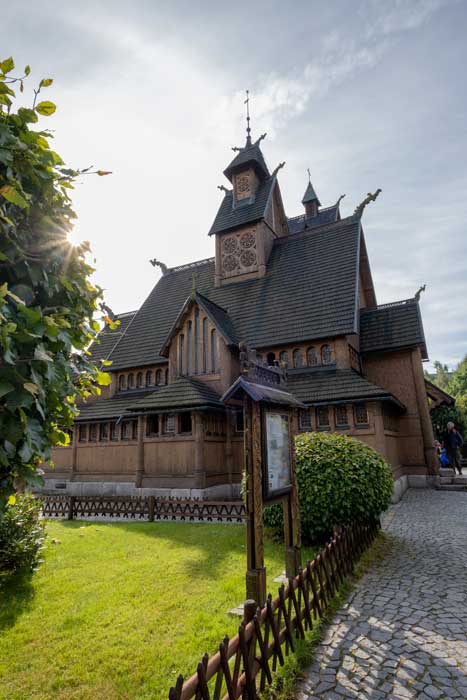
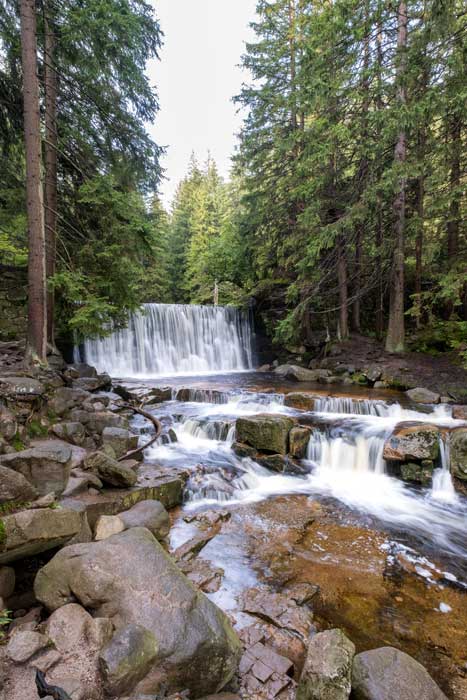

Day 7: Książ Castle
While Chojnik is breathtaking, I also recommend Książ Castle – especially on a rainy day or the last day of your stay in the Karkonosze Mountains.
Why should you visit the Książ Castle?
Książ Castle is the largest Lower Silesian castle and the third largest in Poland. The enormous structure is beautifully situated in the heart of the Książecki Landscape Park. Among the many owners over the centuries, the Hochberg family had the greatest influence on the castle’s current appearance. Today, you can visit the interior of the castle as well as the palm house and underground areas created during the Second World War. The castle’s palm house has 250 species of plants from nearly every continent. The castle’s undergrounds have a depth between 15 and 50 kilometers/9 and 31 miles. Work began on this underground space when there were plans to turn Książ Castle into Hitler’s headquarters.
The construction of these underground structures (code-named “Project Riese”) was the largest construction project of Nazi Germany. To this day, it is not known what the purpose of building the underground was, though its costs were extensive, both in terms of finances and human life. Prisoners of the Gross-Rosen concentration camp were used to build the underground areas.
How do you get to Książ Castle?
Książ Castle is located in Wałbrzych, which is two hours by train from Szklarska Poręba. Next to the railway station, you will find a bus stop. Bus Lines 8 and 12 will take you to the castle. Make sure that the final stop is “Jeździecka – Zamek Książ.” For drivers, the main parking lot is right next to the castle, near the viewing point.
What is the best way to sightsee at Książ Castle?
You can sightsee the castle complex on your own with an audiobook available in various languages. While there, you can see the gardens, the palm house, the castle underground, and the nearby Książecki Landscape Park. An entrance ticket can be easily purchased onsite without a prior reservation. The palm house is included in the price of the castle ticket, while admission to the underground requires a separate ticket. I also recommend stopping at the viewing point in Książecki Landscape Park for the best view of the castle.
Pro Tip. Buy a ticket to the underground in advance to guarantee that you can snag one of the limited spots available each hour.
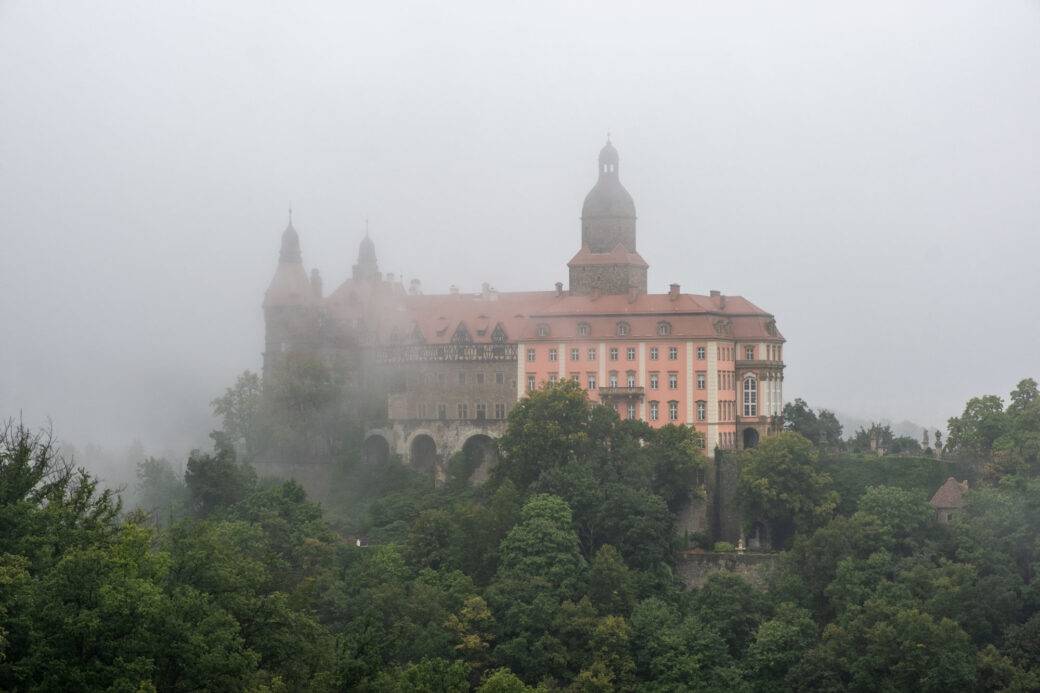
Logistics of planning a trip to the Karkonosze Mountains
Where to stay
Depending on the activities you have planned, I suggest finding lodging in either Szklarska Poręba or Karpacz. From both towns, you can easily get to the Karkonosze Mountasins on foot, and both offer many attractions. I chose to stay in one of Szklarska Poręba’s characteristic villas. I found accommodation through noclegi.pl, which is a Polish portal that helps you find accommodation and rent from individual owners. The site has a strong selection of places to stay and good prices, even if you’re looking for a last-minute deal.
For fans of hiking, there is a large selection of mountain huts. On the Polish side, you will find as many as eleven:
- Hala Szrenicka
- Szrenica
- Samotnia
- Kochanówka
- Kamieńczyk
- Łabski Szczyt
- Odrodzenie
- Strzecha Akademicka
- Dom Śląski
- Nad Łomniczką (Note: facility is currently closed and there are no guest rooms)
- Na Przełęczy Okraj
Where to eat in Szklarska Poręba
The choice of restaurants in Szklarska Poręba is decent. Mostly, you will find Polish cuisine and pizzerias, but there are a few international cuisine options. I love to indulge in pizza, especially after hiking, and I recommend Tomato Pizzeria. They offer speedy delivery for those days when you don’t have the energy to walk to a restaurant. In terms of Polish cuisine, I enjoyed a restaurant called Harnaś, both for its food and service. In particular, they make a great Polish sour rye soup called żurek. Bistorante is another good choice. In addition, you will find local grocery stores in Szklarska Poręba, as well as chain stores such as Lidl or Biedronka, if you prefer to cook.

How to move around the Karkonosze Mountains
If you’re traveling by public transit, Szklarska Poręba is the easiest to reach, as it is the last stop on the “Warsaw – Szklarska Poręba” railway line. The train passes through Wrocław, which is a good place to change trains from other cities in Poland. There are few connections between Szklarska Poręba and Karpacz, except for the weekends, when buses run directly between the two towns. Otherwise, you have to change trains in Jelenia Góra. Most hiking trails are directly accessible from Szklarska Poręba or Karpacz.
When it comes to public transit options for navigating the Karkonosze Mountains, there is a train line known as Koleje Dolnośląskie, as well as buses and minibuses, so you can easily get anywhere. However, this travel takes time, and these transport options are not always the best. A car is definitely more convenient and saves time, but it can also involve additional costs and hassles, such as parking with often limited space for cars. If you plan to spend more time in one of the towns and focus on its surrounding trails, you will not need a car.
Pro Tip: If you find that the train station ticket office is closed, you should find a conductor after boarding the train and buy a ticket immediately. Otherwise you will be considered a stowaway and have to pay a penalty. You can always buy a ticket from the conductor for an additional fee.
Overall
The Karkonosze Mountains are a great place to relax by getting away from the hustle and bustle of the city. You don’t need to be in good shape to enjoy hiking here, as most of the trails are enjoyable without being very demanding. In addition, this region is full of legends hidden around every bend. I very much enjoyed my stay in Szklarska Poręba. I hope that you found my guide to the Polish Karkonosze Mountains and their surrounding areas helpful. Please let me know in the comments if you have any questions.


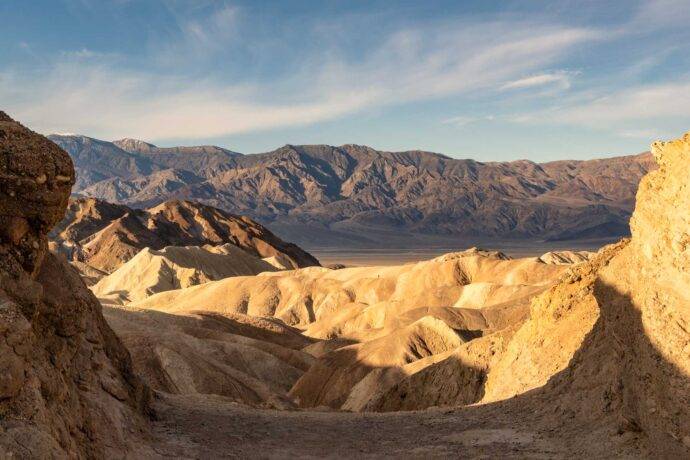
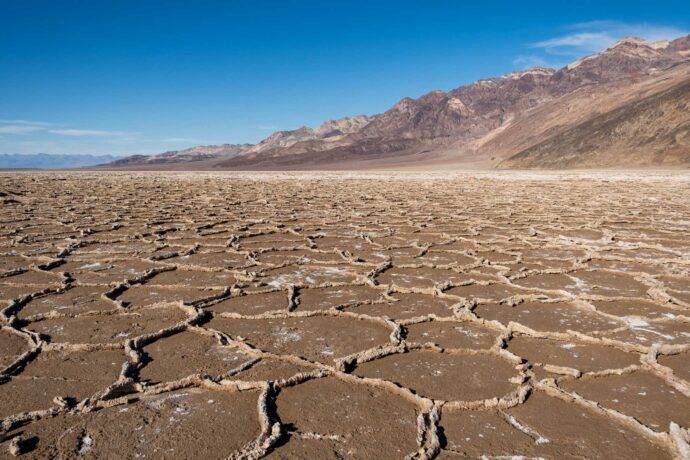

No comments